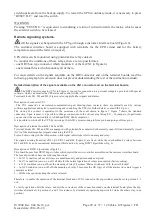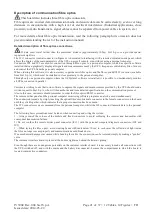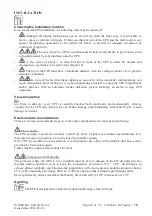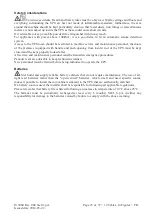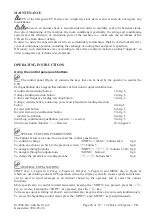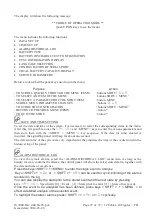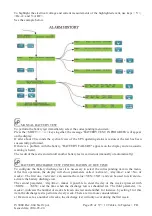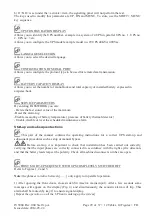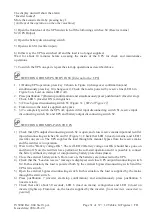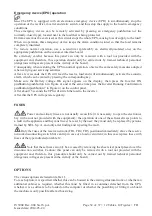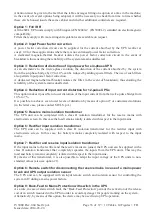
IV306E Rev. 004 Siel S.p.A.
Page 34 of 37 + 12 Tables, 14 F FR
Issued date: 2014-03-24
Option 10: Back-Feed Protection with remote switch
In case of a static switch fault, this device opens a remote switch so as to avoid any hazard for staff
working on the plant.
In the case of options 8 and 10 being envisaged, the remote switch is the same.
Option 11: UPS output isolation sensor for regular operation in IT
In the event of an isolation transformer being fitted at the UPS input, the system can be controlled in
IT by fitting a special earth phase sensor for signalling first fault.
Option 12: Restriction of the input current and inhibition of fast loading for operation
with generator, sequential start of rectifiers.
In case of operation with a generator, an optional circuit can be supplied that restricts the power
absorbed by the rectifier to such a value as not to overload the generator and at the same time inhibit
fast battery charging.
It is also possible to set the sequential start (staggered over time) of several rectifiers in the case of
UPS units connected in parallel.
Option 13: Battery temperature reading kit.
This Kit is necessary only if the UPS haven’t battery inside or if you usen’t Siel battery cabinet.
This Kit communicates battery temperature to the UPS in order to change the recharging voltage. This
sensor can be used only if the battery cabinet is located close to the UPS.
Option 14: Battery cabinet temperature reading kit, by means of optic fibres.
By means of this kit, it is possible to communicate the temperature of the battery compartment to the
UPS unit, even if this is not close to the UPS.
The transmitter located in the battery compartment must be powered with single-phase 230 V AC
current. This voltage does not necessarily have to be continuous because in the case of a mains break,
the batteries are not recharged and the recharge voltage correction signal is not used.
In case of interruption of the optic fibres or no power to the transmitter, the correction circuit
automatically disengages and the batteries are correctly charged at fixed voltage.
NOTE: The length of the fibres must be indicated in the order: 25-50-75m.
Option 15: Customer interface board with RS232 serial port
Besides the features set out in the section entitled Remote Signalling Systems , this board (Figure 6)
also includes an additional DB9 connector (female) for data transmission through an RS232 port;
The serial port is fully insulated from the UPS electronic circuitry and designed to interface with any
computer with a RS232 port.
The interconnection cable must be of the Nullmodem type, i.e. Terminals 2 and 3 must be switched
(this cable can be provided by Siel S.p.A. on request).
The baud rate equals 9600 Bit/sec; the baud rate can only be changed by contacting SIEL service.
Siel provides special software which can graphically display all signals and measurements sent by the
UPS, keep an accurate history file of events, and control the UPS from the personal computer.
Customers wishing to use their own software to capture the signals and measurements provided by the
UPS should send a written request to Siel S.p.A., who will then authorise and issue detailed
specifications on the communication protocol.
All signals provided through RS232 can also be obtained through fibre optics as previously described.
Option 16: Remote mimic panel
The remote digital mimic panel is similar to the control panel provided on the SAFEPOWER series
UPS.
A fibre optic cable is used to connect the digital mimic panel and the control panel; unlike
conventional cables, it provides signals with electrical and magnetic insulation, which have
considerable advantages in terms of transmission safety and reliability.

